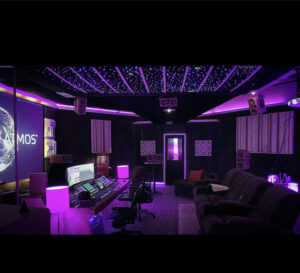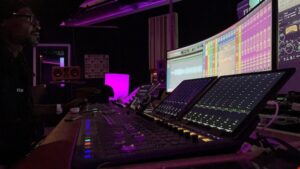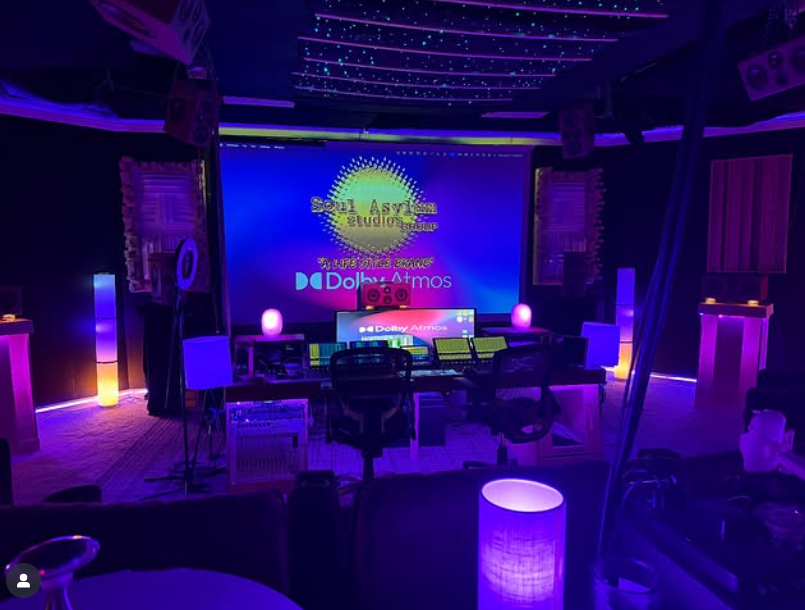Today, when the advancements in technology have pushed the boundaries of immersion, we are witnessing a revolutionary shift in how we experience sound. Unlike how rigid the traditional stereo or even surround sound were. Dolby Atmos offers you an immersive, three-dimensional audio experience.
If you are someone who wishes to create their own Dolby Atmos version of their song. Then, you are on the very right page. In this blog, we will discuss how, and where to begin with.
( Also Read More – Dolby Atmos Music Mastering )
What is Dolby Atmos?
Dolby Atmos is a new technology that is reshaping how you hear sounds, and how every sound wave reaches your ear. Dolby Atmos is an object-based sound format. That allows you to place and move each and every element in a 3-dimensional sound environment.
You can experiment with so many different sound ideas, and place every soundtrack to decide which one feels perfect.
With Dolby Atmos studio Georgia, sounds are no more confined to certain channels, for instance, left, right, up, or down. But exist independently as “objects”, which you can place literally anywhere depending on how you want your music to be. Whether you want the sound to come from above, below, or around your listeners.
Why should you mix in Dolby Atmos?
1. Dolby Atmos provides you with an immersive listening experience. And makes you feel like you are actually a part of it, or inside the song.
2. Most of the music streaming platforms like Apple Music, & Tidal, use Dolby Atmos to enhance the experience of their listeners. Which provides future-proofing, having Dolby Atmos integrated into your song will make it easier to align with these streaming platforms.
3. Most of the listeners look forward to a high-quality, immersive audio experience. And having your music tracks available in Dolby Atmos, will help you gain popularity, visibility, and higher listener engagement.
4. With Dolby Atmos integration, you can endlessly experiment with your music. You can make the individual sound object sound from above, below, or even around the listeners.
( Read More – How to Identify the Dolby Atmos Sound Tracks? )
Steps to Make Dolby Version of Your Song:

Step 1: Prepare Your Session:
The first thing you need to do to create a Dolby Atmos music mix is to prepare a perfect music session. Make sure there is no unwanted noise in the background, and all edits are tight.
If you are working in DAWs, like Pro Tools, Logic Pro, Ableton Live, or Nuendo. Make sure they are all integrated with the latest version of Dolby Atmos technology.
They must offer integrated tools or third-party plugins that help with Atmos mixing, including panning tools and object assignments.
You will also need Dolby Atmos Production Suite. To clearly monitor in binaural, route audio objects, and visualize your mix in 3D space. Dolby Atmos Studio Atlanta provides a perfect place that helps you with session preparation.
Step 2: Upgrade Your Monitor Setup:
If you want to create a Dolby Atmos mix for your next release, you will need a proper monitoring setup. Which is perfectly tailored to spatial audio settings. Here is a brief of what you will generally need to ensure your monitoring setup is upgraded:
- A studio with a 7.1.4 speaker space.
- 7 speakers around you,
- 1 subwoofer
- 4 overhead speakers.
This whole setup costs a fortune, and a huge space to set up. However, fortunately, you can also create your Dolby Atmos mix using a binaural rendering on high-quality headphones.
All you need is additional calibration tools and a careful and perfectly capable ear.
The Dolby Atmos renderer has a binaural monitoring feature which helps in creating a whole 3 dimensional spatial pace on headphones. Hence, making it easy, and possible to create Dolby Atmos mix in a compact studio space.
Dolby Atmos Studios Atlanta suggests recording your Dolby mix in a professional Atmos studio before release to ensure spatial accuracy.
( Advantages of a Pro Recording Studio Over Home Studio )
Step 3: Mix With Object-Based Thinking:
Earlier in the traditional stereo mixing, due to its rigidity, people only used to focus on left-right balance, EQ, compression, and spatial effects like reverb and delay. However, with the advancements in Dolby Atmos, you can now enter into a whole new 3-D sound space.
Where you can place and move each and every soundtrack however you want it to be. Doesn’t matter whether you want to experiment by placing it up, down, behind, or even overhead.
This allows you to creatively experiment with your tracks.
How to mix and pan in the three-dimensional?
- Use Dolby Atmos Panner, or Dolby Atmos renderer for placing each and every sound object in the 3D space.
- Try experimenting with height channels, especially overhead sounds for better immersion of music.
- You can also automate movement for flying effects, swirling synths, or rotating vocals.
- Use reverb and delays, and automate effects to move the elements dynamically in the space.
However, make sure while panning, and mixing you don’t overcrowd your music with many elements. Just because you can use all dimensions doesn’t mean you should.
Leave some space for important elements, and make sure that the vocals and melody remain central and mainly focused.

Step 4: Use The Beds And Objects Strategically:
Dolby Atmos uses a strategic mix of beds and mixes. The bed is a 7.1.4 channel layout used for static elements, and objects move freely in the 3D space. To make your own Dolby Atmos mix, make sure to put a foundation of drums, and bass in the bed.
Make use of sound elements that benefit you from capital movement-. For instance, vocals, synths, and effects. You usually get up to 118 objects, so use them wisely.
It is better to always consider how your mix will downmix to stereo or binaural playback. Make sure your mix sounds good when spatial effects are decreased.
Step 5: Finalize And Export:
The next step is to finalize your mix and then export. It is very essential to export your mix in the best quality possible, the benchmark that you need to follow while exporting is:
48kHz sample rate, 24-bit depth, and proper routing. Verify the mix in Dolby Renderer.
Make sure you have labeled every file clearly, have made backups, and all elements and automation are intact.
Step 6: Distribute your Dolby Atmos Song:
The last step is to distribute your creation. It is better to use distributors like AvidPlay, DistroKid, or LANDR to release on Atmos-supporting platforms.
If required, you can submit both Atmos and stereo versions if required.
( Dolby Atmos Music – Experience Music Like Never Before )
Conclusion:
Creating a Dolby Atmos version of your song is both a technical and creative leap. In this blog, we discussed how you can craft your own Dolby Atmos version of your song.
Follow the steps mentioned in the blog to create your own Dolby Atmos version of the song.If you are someone who’s facing difficulties in finding the best music studio in Atlanta, don’t worry, we got you, the best Dolby Atmos studios Georgia are here to help you out. And if you have queries, we are just a call away.

